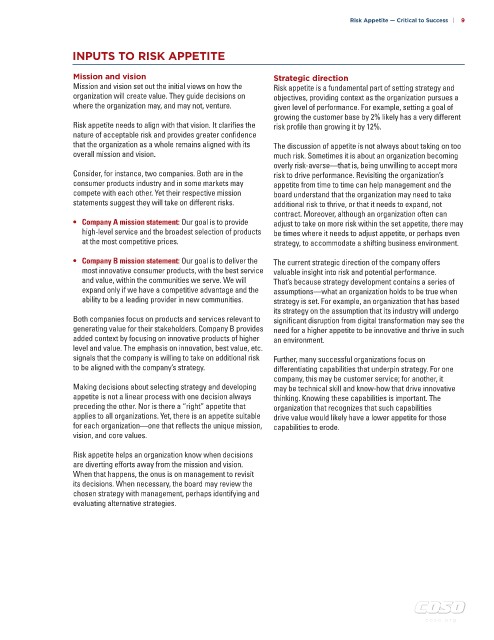Page 481 - COSO Guidance
P. 481
Risk Appetite — Critical to Success | 9
INPUTS TO RISK APPETITE
Mission and vision Strategic direction
Mission and vision set out the initial views on how the Risk appetite is a fundamental part of setting strategy and
organization will create value. They guide decisions on objectives, providing context as the organization pursues a
where the organization may, and may not, venture. given level of performance. For example, setting a goal of
growing the customer base by 2% likely has a very different
Risk appetite needs to align with that vision. It clarifies the risk profile than growing it by 12%.
nature of acceptable risk and provides greater confidence
that the organization as a whole remains aligned with its The discussion of appetite is not always about taking on too
overall mission and vision. much risk. Sometimes it is about an organization becoming
overly risk-averse—that is, being unwilling to accept more
Consider, for instance, two companies. Both are in the risk to drive performance. Revisiting the organization’s
consumer products industry and in some markets may appetite from time to time can help management and the
compete with each other. Yet their respective mission board understand that the organization may need to take
statements suggest they will take on different risks. additional risk to thrive, or that it needs to expand, not
contract. Moreover, although an organization often can
• Company A mission statement: Our goal is to provide adjust to take on more risk within the set appetite, there may
high-level service and the broadest selection of products be times where it needs to adjust appetite, or perhaps even
at the most competitive prices. strategy, to accommodate a shifting business environment.
• Company B mission statement: Our goal is to deliver the The current strategic direction of the company offers
most innovative consumer products, with the best service valuable insight into risk and potential performance.
and value, within the communities we serve. We will That’s because strategy development contains a series of
expand only if we have a competitive advantage and the assumptions—what an organization holds to be true when
ability to be a leading provider in new communities. strategy is set. For example, an organization that has based
its strategy on the assumption that its industry will undergo
Both companies focus on products and services relevant to significant disruption from digital transformation may see the
generating value for their stakeholders. Company B provides need for a higher appetite to be innovative and thrive in such
added context by focusing on innovative products of higher an environment.
level and value. The emphasis on innovation, best value, etc.
signals that the company is willing to take on additional risk Further, many successful organizations focus on
to be aligned with the company’s strategy. differentiating capabilities that underpin strategy. For one
company, this may be customer service; for another, it
Making decisions about selecting strategy and developing may be technical skill and know-how that drive innovative
appetite is not a linear process with one decision always thinking. Knowing these capabilities is important. The
preceding the other. Nor is there a “right” appetite that organization that recognizes that such capabilities
applies to all organizations. Yet, there is an appetite suitable drive value would likely have a lower appetite for those
for each organization—one that reflects the unique mission, capabilities to erode.
vision, and core values.
Risk appetite helps an organization know when decisions
are diverting efforts away from the mission and vision.
When that happens, the onus is on management to revisit
its decisions. When necessary, the board may review the
chosen strategy with management, perhaps identifying and
evaluating alternative strategies.
c oso . or g

